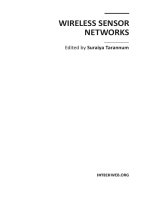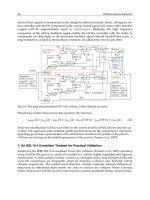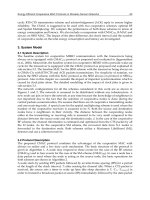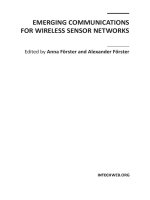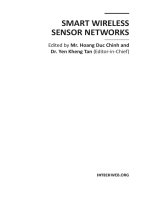Wireless Sensor Networks Application Centric Design Part 1 pot
Bạn đang xem bản rút gọn của tài liệu. Xem và tải ngay bản đầy đủ của tài liệu tại đây (664.87 KB, 30 trang )
Wireless Sensor Networks:
Application‐Centric Design
Edited by Dr. Geoff V Merret and
Dr. Yen Kheng Tan (Editor-in-Chief)
Wireless Sensor Networks: Application-Centric Design
Edited by Dr. Geoff V Merret and Dr. Yen Kheng Tan (Editor-in-Chief)
Published by InTech
Janeza Trdine 9, 51000 Rijeka, Croatia
Copyright © 2010 InTech
All chapters are Open Access articles distributed under the Creative Commons
Non Commercial Share Alike Attribution 3.0 license, which permits to copy,
distribute, transmit, and adapt the work in any medium, so long as the original
work is properly cited. After this work has been published by InTech, authors
have the right to republish it, in whole or part, in any publication of which they
are the author, and to make other personal use of the work. Any republication,
referencing or personal use of the work must explicitly identify the original source.
Statements and opinions expressed in the chapters are these of the individual contributors
and not necessarily those of the editors or publisher. No responsibility is accepted
for the accuracy of information contained in the published articles. The publisher
assumes no responsibility for any damage or injury to persons or property arising out
of the use of any materials, instructions, methods or ideas contained in the book.
Publishing Process Manager Jelena Marusic
Technical Editor Goran Bajac
Cover Designer Martina Sirotic
Image Copyright Ruslan Ivantsova, 2010. Used under license from Shutterstock.com
First published December, 2010
Printed in India
A free online edition of this book is available at www.intechopen.com
Additional hard copies can be obtained from
Wireless Sensor Networks: Application-Centric Design, Edited by Dr. Geoff V Merret
and Dr. Yen Kheng Tan (Editor-in-Chief)
p. cm.
ISBN 978-953-307-321-7
free online editions of InTech
Books and Journals can be found at
www.intechopen.com
Contents
Preface IX
Part 1
Applications and Case Studies 1
Chapter 1
Wireless Sensor Networks - An Introduction 3
Qinghua Wang and Ilangko Balasingham
Chapter 2
Wireless Sensor Networks for On-field
Agricultural Management Process 17
Luca Bencini, Davide Di Palma, Giovanni Collodi,
Gianfranco Manes and Antonio Manes
Chapter 3
Wildlife Assessment using Wireless Sensor Networks 35
Harry Gros-Desormeaux, Philippe Hunel and Nicolas Vidot
Chapter 4
Wireless Sensor Network for Disaster Monitoring 51
Dr. Maneesha Vinodini Ramesh
Chapter 5
Urban Microclimate and Traffic Monitoring
with Mobile Wireless Sensor Networks 71
Francesco Chiti and Romano Fantacci
Chapter 6
Improving Greenhouse’s Automation and
Data Acquisition with Mobile Robot Controlled
system via Wireless Sensor Network 85
István Matijevics and Simon János
Chapter 7
Model Based WSN System Implementations Using PN-WSNA
for Aquarium Environment Control in a House 109
Ting-Shuo Chen and Chung-Hsien Kuo
Chapter 8
Wireless Sensor Network for Ambient Assisted Living 127
Juan Zapata and Francisco J. Fernández-Luque and Ramón Ruiz
VI
Contents
Chapter 9
Chapter 10
Part 2
Monitoring of human movements for fall
detection and activities recognition in elderly
care using wireless sensor network: a survey 147
Stefano Abbate, Marco Avvenuti, Paolo Corsini,
Alessio Vecchio and Janet Light
Odor Recognition and Localization
Using Sensor Networks 167
Rabie A. Ramadan
Communication and Networking Technologies 183
Chapter 11
Modelling Underwater Wireless Sensor Networks 185
Jesús Llor and Manuel P. Malumbres
Chapter 12
Prospects and Problems of Optical Diffuse
Wireless Communication for Underwater
Wireless Sensor Networks (UWSNs) 205
Davide Anguita, Davide Brizzolara and Giancarlo Parodi
Chapter 13
Estimation of Propagation Characteristics along
Random Rough Surface for Sensor Networks 231
Kazunori Uchida and Junichi Honda
Chapter 14
Design of Radio-Frequency Transceivers
for Wireless Sensor Networks 249
Bo Zhao and Huazhong Yang
Chapter 15
MAC & Mobility In Wireless Sensor Networks 271
Marwan Al-Jemeli, Vooi Voon Yap and Fawnizu Azmadi Bin Hussin
Chapter 16
Hybrid Optical and Wireless Sensor Networks 297
Lianshan Yan, Xiaoyin Li, Zhen Zhang, Jiangtao Liu and Wei Pan
Chapter 17
Range-free Area Localization Scheme
for Wireless Sensor Networks 321
Vijay R. Chandrasekhar, Winston K.G. Seah,
Zhi Ang Eu and Arumugam P. Venkatesh
Contents
Part 3
Information and Data Processing Technologies 351
Chapter 18
Data Fusion Approach for Error
Correction in Wireless Sensor Networks 353
Maen Takruri and Subhash Challa
Chapter 19
Target Tracking in Wireless Sensor Networks 373
Jianxun LI and Yan ZHOU
Chapter 20
A Gaussian Mixture Model-based Event-Driven Continuous
Boundary Detection in 3D Wireless Sensor Networks 393
Jiehui Chen, Mariam B.Salim and Mitsuji Matsumoto
Chapter 21
Monitoring Wireless Sensor Network
Performance by Tracking Node operational Deviation 413
Yaqoob J. Y. Al-raisi and Nazar E. M. Adam
Chapter 22
Building Context Aware Network of Wireless
Sensors Using a Scalable Distributed Estimation
Scheme for Real-time Data Manipulation 427
Amir Hossein Basirat and Asad I. Khan
Chapter 23
Multimedia Data Processing and
Delivery in Wireless Sensor Networks 449
Javier Molina, Javier M. Mora-Merchan,
Julio Barbancho and Carlos Leon
Chapter 24
Imaging in UWB Sensor Networks 469
Ole Hirsch, Rudolf Zetik, and Reiner S. Thomä
VII
Preface
About this Book
Over the past decade, there has been a prolific increase in the research, development
and commercialisation of Wireless Sensor Networks (WSNs) and their associated technologies (see Figure 1). This rise has been a result of a number of contributing factors,
including continued miniaturisation (leading towards an era of truly ‘pervasive’ and
‘invisible’ computing); low-power circuits, devices and computation (for example, the
ultra-low-power sleep states now found in microcontrollers); and efficient short-range
communication (such as ZigBee and Bluetooth). The dramatic rise in WSN activity,
fuelled by the prospect of a new computing paradigm, has resulted in the topic being
researched (and taught) in the electronics and computer science departments of Universities around the world.
Figure 1. The increase in research into WSNs, shown by the total number of published papers (as catalogued on the ISI Web of Knowledge) matching the topic (sensor
network*).
X
Preface
While enabling technologies such as low-power circuitry have permitted the conception and growth of WSNs (for example a microcontroller’s ultra-low-power sleep states
enable a vast reduction in the average power consumption obtained through duty cycled operation, a technique which underpins the operation of most implementations),
the principal reason for the explosion of research is, in my opinion, due to the volume of
WSN applications that can be conceived and realised. To name a few, they have found
use in healthcare, defence and security, environmental monitoring, process control,
structural health monitoring, condition monitoring, building automation, multimedia
provision and advertising. However, as a result of the broad array of pertinent applications, WSN researchers have also realised the application specificity of the domain;
it is incredibly difficult, if not impossible, to find an application-independent solution
to most WSN problems (be it a routing algorithm, MAC protocol, energy harvesting
architecture, or data processing algorithm). Hence, research into WSNs dictates the
adoption of an application-centric design process.
Research into WSN applications not only concerns the technical issues and system integration strategies of deployment, but also the communication and processing of data,
alongside the analysis, understanding and modelling of the application parameters
that are of interest. As such, this book is not intended to be a comprehensive review
of all WSN applications and deployments to date. Instead, it is a collection of state-ofthe-art research papers discussing current applications and deployment experiences,
but also the communication and data processing technologies that are fundamental in
further developing solutions to applications. Whilst a common foundation is retained
through all chapters, this book contains a broad array of often differing interpretations,
configurations and limitations of WSNs. I believe that these aid to highlight the rich
diversity and sheer scale of this ever-changing research area.
Organisation
The chapters of this book have been categorised into three distinct sections: applications and case studies (section A), communication and networking technologies (section B), and information and data processing technologies (section C). These are described below:
Applications and Case Studies: The first chapter of this section serves as an introduction to the book, providing a concise overview of WSNs, discussing their history, platforms and architectures, research challenges, and application. The remainder of the
section discusses current applications and their implementation, from experiences of
monitoring agricultural processes to the different methods by which accidental falls of
the elderly can be detected and classified.
Contents
Communication and Networking Technologies: Alongside the predominant theme of
this book, this section contains a collection of state-of-the-art technical papers on application-specific communication and networking problems. These include modelling
wireless propagation through water, routing strategies for hybrid radio frequency/fibre
optic WSNs, through to an overview of radio transceiver design.
Information and Data Processing Technologies: The final section of this book provides
an insight into current research on information and data processing, including data
fusion, target tracking, fault tolerance and multimedia provision in WSNs.
The readership of this book is intended to be postgraduate/postdoctoral researchers,
and professional engineers. Some of the chapters may also be of interest to master’s
level students that are undertaking modules that are particularly relevant to this field.
Dr. Geoff V Merret and Dr. Yen Kheng Tan (Editor-in-Chief)
VII
Part 1
Applications and Case Studies
Wireless Sensor Networks - An Introduction
3
1
0
Wireless Sensor Networks - An Introduction
Qinghua Wang
Dept. of Electronics and Telecommunications
Norwegian University of Science and Technology
Norway
Ilangko Balasingham
Dept. of Electronics and Telecommunications
Norwegian University of Science and Technology
The Interventional Centre, Oslo University Hospital
Institute of Clinical Medicine, University of Oslo
Norway
This chapter provides a detailed introduction to the history and current state of the art with
regard to wireless sensor networks (WSNs).
1. History
The origins of the research on WSNs can be traced back to the Distributed Sensor Networks
(DSN) program at the Defense Advanced Research Projects Agency (DARPA) at around 1980.
By this time, the ARPANET (Advanced Research Projects Agency Network) had been operational for a number of years, with about 200 hosts at universities and research institutes
(Chong & Kumar, 2003). DSNs were assumed to have many spatially distributed low-cost
sensing nodes that collaborated with each other but operated autonomously, with information being routed to whichever node was best able to use the information. At that time, this
was actually an ambitious program. There were no personal computers and workstations;
processing was mainly performed on minicomputers and the Ethernet was just becoming
popular (Chong & Kumar, 2003). Technology components for a DSN were identified in a
Distributed Sensor Nets workshop in 1978 (Proceedings of the Distributed Sensor Nets Workshop, 1978). These included sensors (acoustic), communication and processing modules, and
distributed software. Researchers at Carnegie Mellon University (CMU) even developed a
communication-oriented operating system called Accent (Rashid & Robertson, 1981), which
allowed flexible, transparent accesss to distributed resources required for a fault-tolerant DSN.
A demonstrative application of DSN was a helicopter tracking system (Myers et al., 1984), using a distributed array of acoustic microphones by means of signal abstractions and matching
techniques, developed at the Massachusetts Institute of Technology (MIT).
Even though early researchers on sensor networks had in mind the vision of a DSN, the technology was not quite ready. More specifically, the sensors were rather large (i.e. shoe box and
This work was carried out during the tenure of an ERCIM “Alain Bensoussan” Fellowship Programme and is part of the MELODY Project, which is funded by the Research Council of Norway under
the contract number 187857/S10.
4
Wireless Sensor Networks: Application-Centric Design
up) which limited the number of potential applications. Further, the earliest DSNs were not
tightly associated with wireless connectivity. Recent advances in computing, communication
and microelectromechanical technology have caused a significant shift in WSN research and
brought it closer to achieving the original vision. The new wave of research in WSNs started in
around 1998 and has been attracting more and more attention and international involvement.
In the new wave of sensor network research, networking techniques and networked information processing suitable for highly dynamic ad hoc environments and resource-constrained
sensor nodes have been the focus. Further, the sensor nodes have been much smaller in size
(i.e. pack of cards to dust particle) and much cheaper in price, and thus many new civilian
applications of sensor networks such as environment monitoring, vehicular sensor network
and body sensor network have emerged. Again, DARPA acted as a pioneer in the new wave
of sensor network research by launching an initiative research program called SensIT (Kumar
& Shepherd, 2001) which provided the present sensor networks with new capabilities such
as ad hoc networking, dynamic querying and tasking, reprogramming and multi-tasking. At
the same time, the IEEE noticed the low expense and high capabilities that sensor networks
offer. The organization has defined the IEEE 802.15.4 standard (IEEE 802.15 WPAN Task Group
4, n.d.) for low data rate wireless personal area networks. Based on IEEE 802.15.4, ZigBee
Alliance (ZigBee Alliance, n.d.) has published the ZigBee standard which specifies a suite of
high level communication protocols which can be used by WSNs. Currently, WSN has been
viewed as one of the most important technologies for the 21st century (21 Ideas for the 21st Century, 1999). Countries such as China have involved WSNs in their national strategic research
programmes (Ni, 2008). The commercialization of WSNs are also being accelerated by new
formed companies like Crossbow Technology (Crossbow Technology, n.d.) and Dust Networks
(Dust Networks, Inc., n.d.).
2. Hardware Platform
A WSN consists of spatially distributed sensor nodes. In a WSN, each sensor node is able to
independently perform some processing and sensing tasks. Furthermore, sensor nodes communicate with each other in order to forward their sensed information to a central processing
unit or conduct some local coordination such as data fusion. One widely used sensor node
platform is the Mica2 Mote developed by Crossbow Technology (Crossbow Technology, n.d.).
The usual hardware components of a sensor node include a radio transceiver, an embedded
processor, internal and external memories, a power source and one or more sensors.
2.1 Embedded Processor
In a sensor node, the functionality of an embedded processor is to schedule tasks, process
data and control the functionality of other hardware components. The types of embedded
processors that can be used in a sensor node include Microcontroller, Digital Signal Processor
(DSP), Field Programmable Gate Array (FPGA) and Application-Specific Integrated Circuit
(ASIC). Among all these alternatives, the Microcontroller has been the most used embedded
processor for sensor nodes because of its flexibility to connect to other devices and its cheap
price. For example, the newest CC2531 development board provided by Chipcon (acquired
by Texas Instruments) uses 8051 microcontroller, and the Mica2 Mote platform provided by
Crossbow uses ATMega128L microcontroller.
Wireless Sensor Networks - An Introduction
5
2.2 Transceiver
A transceiver is responsible for the wireless communication of a sensor node. The various
choices of wireless transmission media include Radio Frequency (RF), Laser and Infrared. RF
based communication fits to most of WSN applications. The operational states of a transceiver
are Transmit, Receive, Idle and Sleep. Mica2 Mote uses two kinds of RF radios: RFM TR1000
and Chipcon CC1000. The outdoor transmission range of Mica2 Mote is about 150 meters.
2.3 Memory
Memories in a sensor node include in-chip flash memory and RAM of a microcontroller and
external flash memory. For example, the ATMega128L microcontroller running on Mica2
Mote has 128-Kbyte flash program memory and 4-Kbyte static RAM. Further, a 4-Mbit Atemel
AT45DB041B serial flash chip can provide external memories for Mica and Mica2 Motes (Hill,
2003).
2.4 Power Source
In a sensor node, power is consumed by sensing, communication and data processing. More
energy is required for data communication than for sensing and data processing. Power can
be stored in batteries or capacitors. Batteries are the main source of power supply for sensor
nodes. For example, Mica2 Mote runs on 2 AA batteries. Due to the limited capacity of batteries, minimizing the energy consumption is always a key concern during WSN operations.
To remove the energy constraint, some preliminary research working on energy-harvesting
techniques for WSNs has also been conducted. Energy-harvesting techniques convert ambient energy (e.g. solar, wind) to electrical energy and the aim is to revolutionize the power
supply on sensor nodes. A survey about the energy-harvesting sensor nodes is provided by
(Sudevalayam & Kulkarni, 2008).
2.5 Sensors
A sensor is a hardware device that produces a measurable response signal to a change in a
physical condition such as temperature, pressure and humidity. The continual analog signal
sensed by the sensors is digitized by an analog-to-digital converter and sent to the embedded
processor for further processing. Because a sensor node is a micro-electronic device powered
by a limited power source, the attached sensors should also be small in size and consume
extremely low energy. A sensor node can have one or several types of sensors integrated in or
connected to the node.
3. Operating System
The role of any operating system (OS) is to promote the development of reliable application
software by providing a convenient and safe abstraction of hardware resources. OSs for WSN
nodes are typically less complex than general-purpose OSs both because of the special requirements of WSN applications and because of the resource constraints in WSN hardware
platforms.
TinyOS (TinyOS Community Forum, n.d.) is perhaps the first operating system specifically designed for WSNs. It features a component-based architecture which enables rapid innovation
and implementation while minimizing code size as required by the severe memory constraints
inherent in WSNs. TinyOS’s component library includes network protocols, distributed services, sensor drivers, and data acquisition tools - all of which can be further refined for a
6
Wireless Sensor Networks: Application-Centric Design
custom application. Unlike most other OSs, TinyOS is based on an event-driven programming model instead of multithreading. TinyOS programs are composed into event handlers
and tasks with run-to-completion semantics. When an external event occurs, such as an incoming data packet or a sensor reading, TinyOS calls the appropriate event handler to handle
the event. Event handlers can post tasks that are scheduled by the TinyOS kernel at a later
stage. Both the TinyOS system and programs written for TinyOS are written in a special programming language called nesC which is an extension of the C programming language. NesC
is designed to detect race conditions between tasks and event handlers. Currently, TinyOS has
been ported to over a dozen platforms and numerous sensor boards. A wide community uses
it in simulation to develop and test various algorithms and protocols. According to the figure
published on TinyOS forum, over 500 research groups and companies are using TinyOS on
the Berkeley/Crossbow Motes. Because TinyOS is open source, numerous groups are actively
contributing code to the development of TinyOS and thus making it even more competitive.
Contiki (Contiki, n.d.) is another open source OS specifically designed for WSNs. The Contiki kernel is event-driven, like TinyOS, but the system supports multithreading on a perapplication basis. Furthermore, Contiki includes protothreads that provide a thread-like programming abstraction but with a very small memory overhead. Contiki provides IP communication, both for IPv4 and IPv6. Many key mechanisms and ideas from Contiki have been
widely adopted within the industry. The uIP embedded IP stack, originally released in 2001,
is today used by hundreds of companies in systems such as freighter ships, satellites and oil
drilling equipment. Contiki’s protothreads, first released in 2005, have been used in many
different embedded systems, ranging from digital TV decoders to wireless vibration sensors.
Contiki’s idea of using IP communication in low-power WSNs has lead to an IETF standard
and an international industry alliance - IP for Smart Objects (IPSO) Alliance (IPSO Alliance promoting the use of IP for Smart Objects, n.d.).
There are also other OSs that can be used by WSNs. For example, SOS (SOS Embedded Operating System, n.d.) is an event-driven OS for mote-class sensor nodes that adopts a more
dynamic point on the design spectrum. The prime feature of SOS is its support for loadable
modules. A complete system is built from smaller modules, possibly at run-time. To support the inherent dynamism in its module interface, SOS also focuses on supporting dynamic
memory management. Unfortunately, SOS is no longer under active development due to the
graduation of the core developers. LiteOS (LiteOS, n.d.) is an open source, interactive, UNIXlike operating system designed for WSNs. With the tools that come from LiteOS, it is possible
to operate one or more WSNs in a Unix-like manner. It is also possible to develop programs
for nodes, and wirelessly distribute such programs to sensor nodes.
4. Networking
4.1 Network Architecture
A WSN is a network consisting of numerous sensor nodes with sensing, wireless communications and computing capabilities. These sensor nodes are scattered in an unattended environment (i.e. sensing field) to sense the physical world. The sensed data can be collected by a few
sink nodes which have accesses to infrastructured networks like the Internet. Finally, an end
user can remotely fetch the sensed data by accessing infrastructured networks. Fig. 1 shows
the operation sketch map of WSNs.
In Fig. 1, two kinds of network topologies are shown. The sensor nodes either form a flat
network topology where sensor nodes also act as routers and trasfer data to a sink through
Wireless Sensor Networks - An Introduction
User/
Task Manager Node
7
Internet and
Satellite
Legend
Sink/
Base Station
(a) Flat sensor network;
Fig. 1. The Operation of WSNs.
sensor node
cluster head/
high end sensor node
(b) Clustered sensor network.
multi-hop routing, or a hierarchical network topology where more powerful fixed or mobile
relays are used to collect and route the sensor data to a sink.
4.2 Protocol Stack of WSNs
The protocol stack used by the sink, cluster head and sensor nodes are shown in Fig. 2. According to (Akyildiz et al., 2002), the sensor network protocol stack is much like the traditional protocol stack, with the following layers: application, transport, network, data link,
and physical. The physical layer is responsible for frequency selection, carrier frequency generation, signal detection, modulation and data encryption. The data link layer is responsible
for the multiplexing of data streams, data frame detection, medium access and error control. It
ensures reliable point-to-point and point-to-multipoint connections in a communication network. The network layer takes care of routing the data supplied by the transport layer. The
network layer design in WSNs must consider the power efficiency, data-centric communication, data aggregation, etc. The transportation layer helps to maintain the data flow and may
be important if WSNs are planned to be accessed through the Internet or other external networks. Depending on the sensing tasks, different types of application software can be set up
and used on the application layer.
WSNs must also be aware of the following management planes in order to function efficiently:
mobility, power, task, quality of service (QoS) and security management planes. Among
them, the functions of task, mobility and power management planes have been elaborated
in (Akyildiz et al., 2002). The power management plane is responsible for minimizing power
consumption and may turn off functionality in order to preserve energy. The mobility management plane detects and registers movement of nodes so a data route to the sink is always
maintained. The task management plane balances and schedules the sensing tasks assigned
to the sensing field and thus only the necessary nodes are assigned with sensing tasks and
the remainder are able to focus on routing and data aggregation. QoS management in WSNs
(Howitt et al., 2006) can be very important if there is a real-time requirement with regard to
8
Wireless Sensor Networks: Application-Centric Design
Security Management
QoS Management
Task Management
Mobility Management
Power Management
Application Layer
Transport Layer
Network Layer
Data Link Layer
Physical Layer
Fig. 2. The Protocol Stack of WSNs (This figure is an extended version of Figure 3 in (Akyildiz
et al., 2002)).
the data services. QoS management also deals with fault tolerance, error control and performance optimization in terms of certain QoS metrics. Security management is the process of
managing, monitoring, and controlling the security related behavior of a network. The primary function of security management is in controlling access points to critical or sensitive
data. Security management also includes the seamless integration of different security function modules, including encryption, authentication and intrusion detection. Please refer to the
author’s publications (Wang & Zhang, 2008; 2009) for more information about security management in WSNs. It is obvious that networking protocols developed for WSNs must address
all five of these management planes.
5. Applications
The original motivation behind the research into WSNs was military application. Examples
of military sensor networks include large-scale acoustic ocean surveillance systems for the
detection of submarines, self-organized and randomly deployed WSNs for battlefield surveillance and attaching microsensors to weapons for stockpile surveillance (Pister, 2000). As the
costs for sensor nodes and communication networks have been reduced, many other potential applications including those for civilian purposes have emerged. The following are a few
examples.
5.1 Environmental Monitoring
Environmental monitoring (Steere et al., 2000) can be used for animal tracking, forest surveillance, flood detection, and weather forecasting. It is a natural candidate for applying WSNs
(Chong & Kumar, 2003), because the variables to be monitored, e.g. temperature, are usu-
Wireless Sensor Networks - An Introduction
9
ally distributed over a large region. One example is that researchers from the University of
Southampton have built a glacial environment monitoring system using WSNs in Norway
(Martinez et al., 2005). They collect data from sensor nodes installed within the ice and the
sub-glacial sediment without the use of wires which could disturb the environment. Another example is that researchers from EPFL have performed outdoor WSN deployments on a
rugged high mountain path located between Switzerland and Italy (Barrenetxea et al., 2008).
Their WSN deployment is used to provide spatially dense measures to the Swiss authorities in
charge of risk management, and the resulting model will assist in the prevention of avalanches
and accidental deaths.
5.2 Health Monitoring
WSNs can be embedded into a hospital building to track and monitor patients and all medical resources. Special kinds of sensors which can measure blood pressure, body temperature
and electrocardiograph (ECG) can even be knitted into clothes to provide remote nursing for
the elderly. When the sensors are worn or implanted for healthcare purposes, they form a
special kind of sensor network called a body sensor network (BSN). BSN is a rich interdisciplinary area which revolutionizes the healthcare system by allowing inexpensive, continuous
and ambulatory health monitoring with real-time updates of medical records via the Internet.
One of the earliest researches on BSNs was conducted in Imperial College London, where a
specialized BSN sensor node and BSN Development Kit have been developed (BSN Research
in Imperial College London, n.d.).
5.3 Traffic Control
Sensor networks have been used for vehicle traffic monitoring and control for some time.
At many crossroads, there are either overhead or buried sensors to detect vehicles and to
control the traffic lights. Furthermore, video cameras are also frequently used to monitor
road segments with heavy traffic. However, the traditional communication networks used to
connect these sensors are costly, and thus traffic monitoring is usually only available at a few
critical points in a city (Chong & Kumar, 2003). WSNs will completely change the landscape of
traffic monitoring and control by installing cheap sensor nodes in the car, at the parking lots,
along the roadside, etc. Streetline, Inc. (Streetline, Inc., n.d.) is a company which uses sensor
network technology to help drivers find unoccupied parking places and avoid traffic jams.
The solutions provided by Streetline can significantly improve the city traffic management
and reduce the emission of carbon dioxide.
5.4 Industrial Sensing
As plant infrastructure ages, equipment failures cause more and more unplanned downtime.
The ARC Advisory Group estimates that 5% of production in North America is lost to unplanned downtime. Because sensor nodes can be deeply embedded into machines and there
is no infrastructure, WSNs make it economically feasible to monitor the “health” of machines
and to ensure safe operation. Aging pipelines and tanks have become a major problem in the
oil and gas industry. Monitoring corrosion using manual processes is extremely costly, time
consuming, and unreliable. A network of wireless corrosion sensors can be economically deployed to reliably identify issues before they become catastrophic failures. Rohrback Cosasco
Systems (RCS) (Rohrback Cosasco Systems, n.d.) is the world leader in corrosion monitoring
technology and is applying WSNs in their corrosion monitoring. WSNs have also been sug-
10
Wireless Sensor Networks: Application-Centric Design
gested for use in the food industry to prevent the incidents of contaminating the food supply
chain (Connolly & O’Reilly, 2005).
5.5 Infrastructure Security
WSNs can be used for infrastructure security and counterterrorism applications. Critical
buildings and facilities such as power plants, airports, and military bases have to be protected
from potential invasions. Networks of video, acoustic, and other sensors can be deployed
around these facilities (Chong & Kumar, 2003). An initiative in Shanghai Pudong International Airport has involved the installation of a WSN-aided intrusion prevention system on
its periphery to deter any unexpected intrusions. The Expo 2010 Shanghai China (Expo 2010
Shanghai China, n.d.) has also secured its expo sites with the same intrusion prevention system.
6. Security
While the future of WSNs is very prospective, WSNs will not be successfully deployed if
security, dependability and privacy issues are not addressed adequately. These issues become
more important because WSNs are usually used for very critical applications. Furthermore,
WSNs are very vulnerable and thus attractive to attacks because of their limited prices and
human-unattended deployment (Wang & Zhang, 2009).
6.1 Security Threats in WSNs
A typical WSN consists of hundreds or even thousands of tiny and resource-constrained sensor nodes. These sensor nodes are distributedly deployed in uncontrollable environment for
the collection of security-sensitive information. Individual sensor nodes rely on multi-hop
wireless communication to deliver the sensed data to a remote base station. In a basic WSN
scenario, resource constraint, wireless communication, security-sensitive data, uncontrollable
environment, and even distributed deployment are all vulnerabilities. These vulnerabilities
make WSNs suffer from an amazing number of security threats. WSNs can only be used in
the critical applications after the potential security threats are eliminated.
6.1.1 Physical Layer Threats
Comparing WSNs with traditional networks, there are more threats to WSNs in the physical
layer, due to the non-tamper-resistant WSN nodes and the broadcasting nature of wireless
transmission. Typical types of attacks in the physical layer include physical layer jamming
and the subversion of a node.
6.1.2 Link Layer Threats
The data link layer is responsible for the multiplexing of data streams, data frame detection,
medium access, and error control. The following attacks can happen in the link layer of WSNs:
Link layer jamming; Eavesdropping; Resource exhaustion and traffic analysis.
6.1.3 Network Layer Threats
Threats in the network layer mostly aim at disturbing data-centric and energy efficient multihop routing, which is the main design principle in WSNs. The following threats and attacks
in this layer are identified in (Wang & Zhang, 2009): Spoofed, altered, or replayed routing information; Sybil attack; Selective forwarding; Sinkhole attack; Wormhole attack and flooding.
Wireless Sensor Networks - An Introduction
11
6.1.4 Application Layer Threats
Many WSNs’ applications heavily rely on coordinated services such as localization, time synchronization, and in-network data processing to collaboratively process data (Sabbah et al.,
2006). Unfortunately, these services represent unique vulnerabilities such as: False data filtering; Clock un-synchronization; False data injection.
6.2 Countermeasures
WSN Threats presented above either violate network secrecy and authentication, such as
packet spoofing, or violate network availability, such as jamming attack, or violate some other
network functionalities. Generally, countermeasures to the threats in WSNs should fulfill the
following security requirements (Wang & Zhang, 2009):
• Availability, which ensures that the desired network services are available whenever
required.
• Authentication, which ensures that the communication from one node to another node
is genuine.
• Confidentiality, which provides the privacy of the wireless communication channels.
• Integrity, which ensures that the message or the entity under consideration is not altered.
• Non-reputation, which prevents malicious nodes to hide or deny their activities.
• Freshness, which implies that the data is recent and ensures that no adversary can replay old messages.
• Survivability, which ensures the acceptable level of network services even in the presence of node failures and malicious attacks.
• Self-security, countermeasures may introduce additional hardware and software infrastructures into the network, which must themselves be secure enough to withstand attacks.
Depending on applications, countermeasures should also fulfill appropriate performance requirements.
6.2.1 Key Management
When setting up a sensor network, one of the first security requirements is to establish cryptographic keys for later secure communication. The established keys should be resilient to
attacks and flexible to dynamic update. The task that supports the establishment and maintenance of key relationships between valid parties according to a security policy is called key
management. Desired features of key management in sensor networks include energy awareness, localized impact of attacks, and scaling to a large number of nodes.
6.2.2 Authentication
As sensor networks are mostly deployed in human-unattended environments for critical sensing measurements, the authentication of the data source as well as the data are critical concerns. Proper authentication mechanisms can provide WSNs with both sensor and user identification ability, can protect the integrity and freshness of critical data, and can prohibit and
identify impersonating attack. Traditionally, authentication can be provided by public-key
schemes as digital signature and by symmetric-key schemes as message authentication code
(MAC). Besides, key-chain schemes using symmetric keys determined by asymmetric keyexchange protocols are also popular for broadcast authentication in WSNs.
12
Wireless Sensor Networks: Application-Centric Design
6.2.3 Intrusion Detection
Security technologies, such as authentication and cryptography, can enhance the security of
sensor networks. Nevertheless, these preventive mechanisms alone cannot deter all possible attacks (e.g., insider attackers possessing the key). Intrusion detection, which has been
successfully used in Internet, can provide a second line of defense.
6.2.4 Privacy Protection
As WSN applications expand to include increasingly sensitive measurements in both military
tasks and everyday life, privacy protection becomes an increasingly important concern. For
example, few people may enjoy the benefits of a body area WSN, if they know that their
personal data such as heart rate, blood pressure, etc., are regularly transmitted without proper
privacy protection. Also, the important data sink in a battlefield surveillance WSN may be
firstly destroyed, if its location can be traced by analyzing the volume of radio activities.
7. Standardization
In the area of WSNs, several standards are currently either ratified or under development. The
major standardization bodies are the Institute of Electrical and Electronics Engineers (IEEE),
the Internet Engineering Task Force (IETF), the International Society for Automation (ISA)
and the HART Communication Foundation, etc. These standardization bodies have different
focuses and they provide global, open standards for interoperable, low-power wireless sensor
devices. Table 1 provides the comparisons of different standards currently available for the
communication protocols of WSNs.
7.1 IEEE 802.15.4
IEEE 802.15.4 is a standard which specifies the physical layer and MAC layer for low-rate
wireless personal area networks. It is the basis for the ZigBee and WirelessHART specification,
each of which further attempts to offer a complete networking solution by developing the
upper layers which are not covered by the standard.
The features of IEEE 802.15.4 include (IEEE 802.15 WPAN Task Group 4, n.d.):
• Data rates of 250 kbps, 40 kbps, and 20 kbps.
• Two addressing modes; 16-bit short and 64-bit IEEE addressing.
• Support for critical latency devices, such as joysticks.
• CSMA-CA channel access.
• Automatic network establishment by the coordinator.
• Fully handshaked protocol for transfer reliability.
• Power management to ensure low power consumption.
• 16 channels in the 2.4GHz ISM band, 10 channels in the 915MHz ISM band and one
channel in the 868MHz band.
7.2 Zigbee
ZigBee is a standard for a suite of high level communication protocols based on the IEEE
802.15.4 standard for low power and low data rate radio communications. Zigbee is initiated
and maintained by the Zigbee Alliance - a large consortium of industry players. The typical application areas of Zigbee include: Smart energy monitoring; Health care monitoring;
Remote control; Building automation and home automation, etc.
Wireless Sensor Networks - An Introduction
13
7.3 WirelessHART
WirelessHART is an open-standard wireless mesh network communications protocol designed
to meet the needs for process automation applications. The protocol utilizes IEEE 802.15.4
compatible DSSS radios and it is operating in the 2.4GHz ISM radio band. On the data link
layer, the protocol uses TDMA technology to arbitrate and coordinate communications between devices. WirelessHART provides highly secure communications by using AES-128
block ciphers with individual Join and Session Keys and Data-Link level Network Key. WirelessHART supports the standard HART Application Layer and is compatible with existing
HART tools, applications and system integration technology. The other outstanding features
of WirelessHART include reliability and scalability. Typically, the communication reliability
for a well-formed WirelessHART network is greater than 3σ and normally greater than 6σ.
Adding new devices can further improve the network and its communication reliability.
8. Summary
WSNs have been identified as one of the most prospective technologies in this century. This
chapter provides information concerning both its history and current state of the art. In concrete terms, the authors provide an overview about the hardware, software and networking
protocol design of this important technology. The authors also discuss the security and ongoing standardization of this technology. Depending on applications, many other techniques
such as localization, synchronization and in-network processing can be important, which are
not discussed in this chapter.
9. References
21 Ideas for the 21st Century (1999). Business Week pp. 78–167.
Akyildiz, I. F., Su, W., Sankarasubramaniam, Y. & Cayirci, E. (2002). A survey on sensor
networks, IEEE Communications Magazine 40(8): 102–114.
Barrenetxea, G., Ingelrest, F., Schaefer, G. & Vetterli, M. (2008). Wireless sensor networks for
environmental monitoring: The sensorscope experience, Proc. of 20th IEEE International Zurich Seminar on Communications (IZS’08).
BSN Research in Imperial College London (n.d.). />Chong, C.-Y. & Kumar, S. P. (2003). Sensor networks: Evolution, opportunities, and challenges,
Proceedings of the IEEE 91(8): 1247–1256.
Connolly, M. & O’Reilly, F. (2005). Sensor networks and the food industry, Proc. of Workshop
on Real-World Wireless Sensor Networks (REALWSN’05).
Contiki (n.d.). />Crossbow Technology (n.d.). .
Dust Networks, Inc. (n.d.). .
Expo 2010 Shanghai China (n.d.). .
Hill, J. L. (2003). System Architecture for Wireless Sensor Networks, PhD thesis, Doctor of Philosophy in Computer Science, University of California at Berkeley, USA.
Howitt, I., Manges, W. W., Kuruganti, P. T., Allgood, G., Gutierrez, J. A. & Conrad, J. M.
(2006). Wireless industrial sensor networks: Framework for qos assessment and qos
management, ISA Transactions 45(3): 347–359.
IEEE 802.15 WPAN Task Group 4 (n.d.). />IPSO Alliance - promoting the use of IP for Smart Objects (n.d.). .

